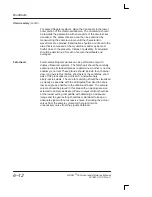
Bioeffects
LOGIQ 500 Advanced Reference Manual
2276614–100 Rev. 0
6–9
Implementing ALARA Methods
The primary objective for any ultrasound examination is to
obtain diagnostic information of sufficient quality to benefit the
patient. Image quality can usually be improved by increasing
the acoustic output or taking more time to refine the image.
These same actions, however, will also increase the risk of
harmful bioeffects when imaging sensitive tissues or when high
output levels are used. The operator is therefore encouraged to
use the lowest acoustic output setting necessary to produce
clinically acceptable data.
The principle of ALARA, which stands for As Low As
Reasonably Achievable, is to keep the radiation exposure at the
minimum level necessary to obtain the diagnostic information.
This principle is widely practiced in medical x-ray protection
where exposure at any level is potentially harmful. Historically,
ALARA was initiated as a cautious approach for dealing with
uncertain hazards but has since become the principle method
for reducing the risk of injury from hazards that do not have safe
minimum threshold.
While no minimum thresholds for harmful bioeffects have been
established with the use of diagnostic ultrasound, the principle
of ALARA can be readily implemented on equipment
incorporating an output display. As the operator adjusts the
equipment to optimize the image quality, the display
interactively updates to indicate the effect on output.
Controls that have no noticeable impact on image quality
should be set to minimize the output while controls that improve
the image quality and also increase acoustic output should be
set no higher than needed to achieve a diagnostic quality
image. If the output display indicates values much greater than
1.0, the operator should reduce the exposure time and freeze
the image as soon as possible.
At very low levels (< 0.4), the display is inactive and the
potential for harmful bioeffect is negligible. More detailed
information concerning the use of ALARA in medical practice
can be found in NCRP Report No. 107
2
.
Summary of Contents for Logiq 500
Page 1: ......
















































